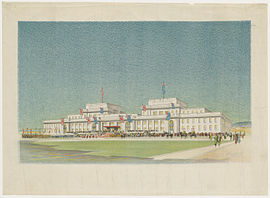Commonwealth Heritage List
 A copy of the commemorative picture to mark the opening of the first Commonwealth Parliament at Old Parliament House, on 9 May 1927. | |
| Type | Heritage register of natural, historic and indigenous places that are owned by the Commonwealth of Australia |
|---|---|
| Country | Australia |
| Years | 2012 – present |
| Preceded by | Register of the National Estate |
| Compiled by | Commonwealth of Australia via the Australian Heritage Council |
The Commonwealth Heritage List is a heritage register which lists places under the control of the Australian government, usually on land or in waters directly owned by the Crown (i.e., the Crown in right of the Commonwealth of Australia). Such places must have importance in relation to the natural, indigenous and historic heritage of Australia. The List was established under the Federal Environment Protection and Biodiversity Conservation Act 1999 (EPBC Act).[1]
Places protected under the Act include federally owned telegraph stations, defence sites, migration centres, customs houses, lighthouses, national institutions such as Parliament and High Court buildings, memorials, islands and marine areas.
History
In 2004, a new heritage management system was introduced by the Australian Government to protect Australia’s heritage places. Key elements are amendments to the Environment Protection and Biodiversity Conservation Act 1999 (Cwth), which include explicit requirements for cultural heritage protection, the creation of an Australian National Heritage List and a Commonwealth Heritage List and the establishment of the Australian Heritage Council under the Australian Heritage Council Act 2003. The Register of the National Estate was retained but lost its statutory power.
The National Heritage List is to include a small number of places of outstanding heritage significance to Australia.
Composition
As of 28 September 2017[update], the Commonwealth Heritage List comprised 398 heritage places as follows:[2]
| State/territory | Number of places |
|---|---|
| Australian Capital Territory | 83 |
| New South Wales | 130 |
| Northern Territory | 12 |
| Queensland | 31 |
| South Australia | 11 |
| Tasmania | 20 |
| Victoria | 41 |
| Western Australia | 20 |
List
See also
References
- ^ "Environment Protection and Biodiversity Conservation Act 1999, Section 324A". Australasian Legal Information Institute. Retrieved 28 June 2015.
- ^ "Search: Commonwealth Heritage List". Australian Heritage Database. Deaprtment of the Environment and Energy, Australian Government. Retrieved 28 September 2017.
